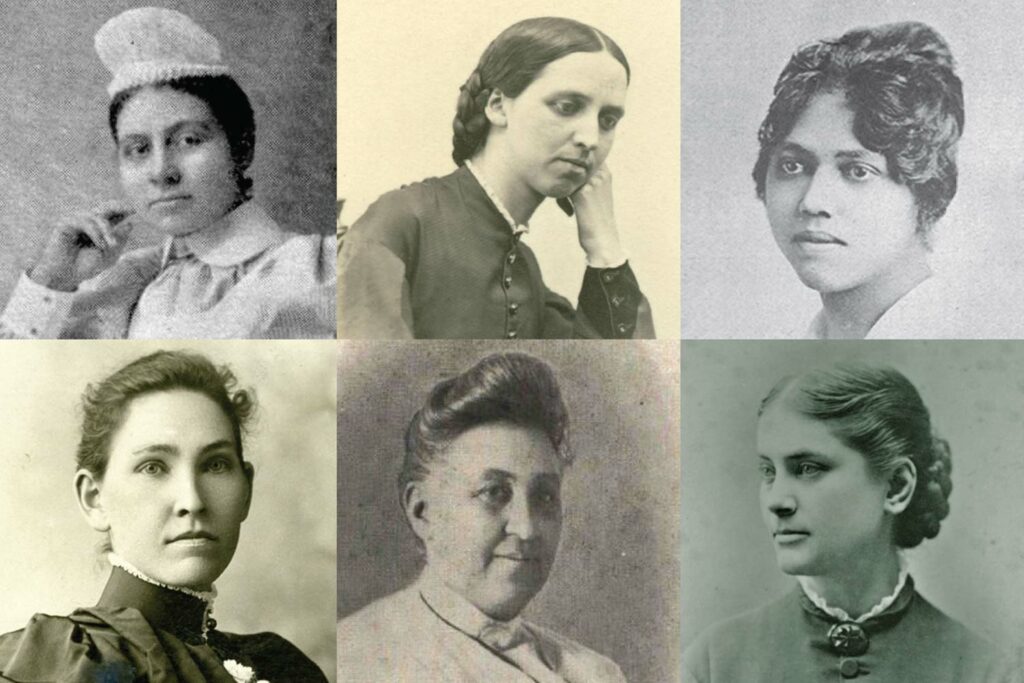Students Help Reclaim Role of Women in Adventist History
Pacific Union College team assists in recovering long-buried information, stories.
August 8, 2022 | California, United States | Laura Gang
A group of students at Pacific Union College (PUC) has helped document the role of women in Adventist history by submitting new research to the Encyclopedia of Seventh-day Adventists.
Maud Sisley, Alma McKibbin, Ruth Temple, Adventist women of firsts and pioneers in mission, education, and health care, were once household names. But their stories were forgotten — buried by time and societal change from the church’s collective memory.
As Jim Wibberding, professor of applied theology and biblical studies at PUC, studied the church archives, he discovered the names of women he’d never heard of before. Wibberding was surprised to learn that so many women were “prominent in shaping Adventism as we know it today.”

Faces of women in Adventist history. Top row, from left: Anna Knight, L. Flora Plummer, Ruth Temple. Bottom row, from left: Alma McKibbin, Minnie Sype, Maud Sisley Boyd. [Photos/collage provided by Pacific Union College]
Starting with 50 names, Wibberding organized a course on the History of Adventist Women, dedicated to telling the stories of female leaders who shaped the church’s faith and mission. He invited 14 additional Adventist historians to be guest speakers.
Choosing which women’s biographies to share proved difficult. A dilemma arose, Wibberding said, when almost every presenter had other forgotten female figures to add to the list from their own primary-document research.
The problem of underrepresentation of women in history is not unique to the Adventist church. Women have been overlooked throughout U.S. and world history. Across the globe, there are concerted efforts being made to fill these gaps. The first step toward that goal, historians concur, is research and storytelling.
To his class of 25 students, Wibberding and the other historians told stories and shared photographs of more than 30 remarkable Adventist women and recounted their often uncredited contributions to the church and its mission.
Maud Sisley left her hometown of Battle Creek and struck out on her own to do mission work in Ohio, Switzerland, England, South Africa, Australia, and beyond. She helped introduce Adventism around the world.
Alma McKibbin wrote the first Adventist elementary school curriculum and became a professor at PUC.
Flora Plummer was “an architect of Sabbath School as we know it today” and served for decades as the sole woman on the General Conference Executive Committee.
Ruth Temple was the first Black woman to graduate from Loma Linda University. From there she devoted herself to helping low-income, underserved communities in Los Angeles receive free and affordable health care. Temple opened the first medical clinic in Southeast Los Angeles. Her leadership there, according to historian Benjamin Baker, eradicated more than one epidemic — including an outbreak of the plague.
Why were these women marginalized? Part of it “has to do with the [culture] of domesticity and the rise of fundamentalism that eclipsed women in ministry within the church,” Michael Campbell, new NAD Archives, Research & Statistics director, said. Campbell, a historian who recently served as a religion professor at Southwestern Adventist University, told the stories of 12 women to Wibberding’s class. Following that experience, he wrote a reflection paper on the major themes that emerged from his research.
Campbell said some missionary women married and their husband’s stories were glorified without any mention of their contributions. Ana Stahl was initially denied entrance to Battle Creek College because she was already married with a child. Evangelist and pastor Minnie Sype was served with retirement papers from the conference because she remarried at 61 and “had a man to care for her.”
Like other significant women in our nation’s history, however, these Adventist leaders found ways to work around gender discrimination. Many female missionaries were especially effective at converting women in other cultures.
Campbell also notes that the Great Awakening created an avenue for women to become Adventist leaders. “Ellen White was actually part of a larger group of women who provided support and evangelism, as well as leadership,” he said. She herself advocated for women and their leadership roles in the church.
Wibberding agreed. It was in the decades following White’s death “when Adventism moved away from gender equality and women’s stories stopped being told,” he said.
Students were not just passive listeners in Wibberding’s class. They became storytellers themselves. Each student chose and researched a female Adventist leader and then wrote and submitted a short biography for the Encyclopedia of Seventh-day Adventists.
Ashley Garner, a sophomore studying psychology and English, enjoyed the exploratory part of the class. “We had the chance to not only uncover but share their history for one of the first times,” Garner said.
Garner researched and wrote about Theresa Kennedy. A missionary, nurse practitioner, and professor, Kennedy chaired the nursing departments of three Adventist colleges. In addition to her work, she was a classical pianist.
Like other important Adventist women in history, Kennedy did the work of many people during her lifetime.
“The Adventist Church has always been made up of a majority of women, many of whom have worked within their ability and influence for the mission of the church,” Campbell said. “We need to be intentional in telling their stories.”
Twenty of the PUC students in Wibberding’s class submitted articles to the online encyclopedia, making a significant contribution to scholarship. In researching primary documents from around the world and publishing the stories of extraordinary women, they became active participants in restoring these names to the pages of Adventist history.
The original version of this story was posted on the North American Division news site.